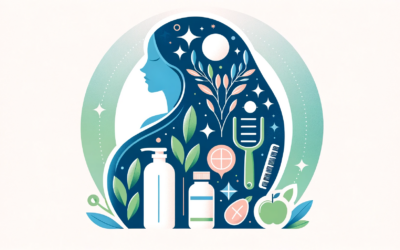Female Hair Loss Stages: The Science Behind Hair Growth
Introduction
Hair loss in women, often a source of distress and diminished confidence, can be better understood and managed by delving into the science of hair growth.
Each strand of hair on our head goes through a life cycle that includes growth, rest, and shedding. By understanding these stages, women experiencing hair loss can better identify the causes and seek effective treatments.
This article explores the four crucial stages of hair growth, offering insights into how they relate to female hair loss and guiding you towards the right solutions.
The Four Stages of Hair Growth
Anagen (Growth Phase)
The anagen phase is the period of active hair growth, which can last between two to seven years. During this stage, hair follicles are pushing out hairs that will continue to grow until they are cut or reach the end of their lifespan.
The length of this phase determines the maximum length of your hair.
Factors like genetics, age, and overall health can influence the duration of the anagen phase.
Catagen (Transition Phase)
Lasting about 10 days, the catagen phase is a transitional stage where hair growth slows down, and the hair follicle shrinks.
The hair detaches from the blood supply and moves up towards the skin’s surface. This phase marks the end of the active growth of a hair.
Telogen (Resting Phase)
In the telogen phase, which can last around three months, hair does not grow but does not fall out either.
The follicle remains dormant during this time. At any given moment, about 10-15% of hairs are in this phase.
At the end of the telogen phase, the hair follicle re-enters the anagen phase, and new hair begins to grow, pushing the old hair out.
Exogen (New Hair Phase)
This phase is part of the hair renewal process. It’s when the old hair falls out, and new hair continues to grow.
The exogen phase can last around 2-5 months. On average, a healthy person sheds between 50-100 hairs a day, mostly during washing, brushing, or styling.
How Hair Growth Stages Relate to Hair Loss
Disruptions in any of these stages can lead to hair loss or thinning. For example, if hairs enter the telogen phase too early, it can result in increased shedding and thinning, a condition known as telogen effluvium. Understanding which stage is affected can help in identifying the cause and finding the right treatment.
Female Pattern Baldness Stages
According to the Cleveland Clinic, female pattern baldness symptoms include thinning or hair loss around the center part, widening of the part, and hair loss throughout the top of the head.
The progression starts near the center parting and can worsen without treatment. The causes include age, hormones, and genetics.
Female pattern baldness is recognizable and can be confirmed by a healthcare provider through a physical exam of the scalp and possibly a densitometer to measure hair follicle thickness.
Diagnosis and Treatment
A healthcare provider may use various methods to diagnose female pattern baldness, including scalp biopsies and blood tests.
Treatments can include medications like Minoxidil and Finasteride, hair transplants, platelet-rich plasma, red light therapy, and styling techniques.
How effective a treatment is can vary and a healthcare provider can help find the right option.
Stages of Female Pattern Baldness
The stages of female pattern baldness can be measured on the Ludwig scale. This scale groups hair loss into three types.
- Type I – thinning hair on top of the head
- Type II – scalp is visible through the hair
- Type III – extensive hair loss making the scalp clearly visible
Female pattern baldness is often inherited, and while it can become irreversible if untreated, certain treatments can promote regrowth.
Progression and Psychological Effects
Dermatologists emphasize that female pattern hair loss typically progresses slowly, starting at the crown and spreading outward.
The psychological impact, including anxiety, depression, and decreased self-esteem, is significant and addressing these effects is part of the treatment.
This is why it is important to have a comprehensive medical history and physical examination for the correct diagnosis.
Frequently Asked Questions
What are the four stages of hair growth?
The four stages of hair growth are Anagen (growth phase), Catagen (transition phase), Telogen (resting phase), and Exogen (shedding/new hair phase). Each stage plays a specific role in the life cycle of a hair strand.
How long does the Anagen phase typically last, and what happens during this stage?
The Anagen phase, or growth phase, can last between two to seven years. During this time, hair follicles push out hairs that will continue to grow until they reach their maximum length or are cut.
What occurs during the Catagen phase of hair growth?
The Catagen phase is a transitional stage lasting about 10 days. Here, hair growth slows down, and the hair follicle shrinks. The hair detaches from its blood supply and begins to move up towards the skin’s surface.
Can changes in the Telogen phase lead to hair loss?
Yes, if more hairs enter the Telogen phase (resting phase) than usual, it can lead to increased shedding and thinning, a condition known as Telogen effluvium. In this phase, hair doesn’t grow but stays attached to the follicle for about three months before falling out.
What is the Exogen phase in hair growth?
The Exogen phase is part of the hair renewal process where old hair falls out, and new hair continues to grow. This phase can last around 2-5 months, and it’s normal to shed between 50-100 hairs a day during this stage, mostly during washing, brushing, or styling.






0 Comments